|
|
|
Great site!
Just wondering about
those players who were the last to wear helmets without a chin strap. As I
remember it from the glory days of the AFL in the late 60's, the Jets' Don
Maynard (#13) wore a single bar set-up with some sort of cheek pads that
extended outside the boundaries of his helmet above the bar. I have watched
several games on TV with him performing without his chin strap. Several
pix exist to date that verifies this. Bake Turner, another Jets WR (#29) may
have also followed Don's lead. Also, the Detroit Lions had a safety(?) who held
for field goals in the early 1970's that wore the helmet without the face bar.
But, I don't think he wore the same helmet in the defensive backfield. And, I
have vivid recollections of a rookie QB named Bradshaw (1970-71) wearing his hat
without a chin strap for several games, also. I remember when he performed in
some college all-star game that he went most of that game wearing his college
helmet but no strap (to prove his toughness, I guess.) The instances I have
described occurred from 1968 through the early 70's. What gives? Additionally,
Jerry Mays, DE for the 69 Super Chiefs, started Super Bowl IV wearing a Schutt
T-bar cage but finished with a DungardDG-120 (LB's). I think Joe Kapp may have
damaged it with his throwing hand on a follow-thru to Mays' face during the
second or third quarter. (O.K., maybe that's just a little bit, too much
trivia.)
Chief's fan.
Dave T.
Dear Dave,
Thanks for the interesting questions and observations. Some of the more
prominent players to not wear a chinstrap include Don Meredith, Sonny Jurgensen,
Don Maynard and Daryle Lamonica. Former Eagles receiver Ben Hawkins was known
for wearing a chinstrap but not snapping it to both sides of the helmet which
left it constantly dangling during play. Don Maynard had many quirks about his
uniform. He personally designed and produced the unique jaw pads you refer to.
They extended beyond the jaw line to also protect the cheekbone area (SEE
PHOTO). He started wearing these special pads after suffering a facial injury.
Both Wayne Rasmussen and Bruce Maher were the Lions players who did not wear a
facemask while holding the ball for the place-kicker although both wore a one
bar facemask while playing in the defensive backfield.
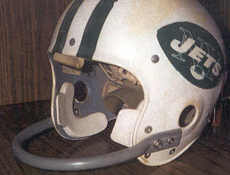 |
Maynard's Game worn
HEY DOCTOR:
I HAVE A WHOLE LIST OF QUESTIONS ON WARNING LABELS:
WHEN DID WARNING LABELS FIRST APPEAR ON THE BACK OF NCAA AND NFL HELMETS? WAS IT
WHEN WE AS A SOCIETY BECAME LITIGATION HAPPY, FORCING HELMET MANUFACTURERS TO
TRY AND PROTECT THEMSELVES? THE ONES THAT COME TO MIND ARE THE WHITE BACKGROUND
WITH BLACK TEXT. AND THEN THE CLEAR WITH BLACK TEXT WHICH GAVE BIRTH TO THE
CLEAR WITH COLORED TEXT. WHEN DID THE CLEAR LABELS COME ABOUT? AND NOW IN THE
LAST COUPLE OF YEARS THE SMALL LABELS ARE IN USE. CAN YOU SHED ANY LIGHT ON THE
WARNING LABELS?
THANKS DOC
CHRIS
Dear Chris:
Are you suggesting that the verbiage contained on warning labels is not read and
by players every time they get ready to use their helmets? We heard the lawyers
are now considering a lawsuit against Riddell because the warning labels are not
bilingual which put many of the NFL kickers at great risk (just kidding Garo,
Jan and Rafael). Actually warning labels first started to appear on NFL helmets
in the 1983 season. Warning labels have been reworded, downsized, color
coordinated with team uniforms, and changed shape since that time. The St. Louis
Rams have worn rectangular shaped warning labels that are taller rather than
wider and fit on the rear center ridge of the helmet. The Dolphins have worn
rectangular shaped warning labels that were shortened in height but lengthened
in width. The customized warning labels are produced by the same decal company
that also provides the helmet logos and striping to the team. Regardless of what
type of warning sticker will ultimately be used by a team the helmet
manufacturing companies still insist on using hard to remove plain black on
white stickers that are attached when the helmet is manufactured. According to
Riddell management this is done to legally demonstrate that the company is doing
everything it can to provide a clear and legible warning for the player to read.
Four potential questions for your
web-site. Feel free to choose any,
all, or none.
1. What was the deal on the face mask Lance Rentzel wore in the 1969 NFL Eastern
Division playoff against Cleveland (perhaps he wore it all
season, but I only have footage from that one game). Did any other players use
this mask?
--Lance wore this mask the entire season to protect a facial injury he
received. (SEE PHOTO) The mask was made by Marrietta and was quite popular with
southwest colleges such as Texas in the early 1960s who also chose to wear
Marietta helmets. This mask type was not popular in the NFL although some of the
early 1960s Steelers including Ernie Stautner (SEE PHOTO) and John Baker wore
masks made by Marrietta that predated the model used by Lance.
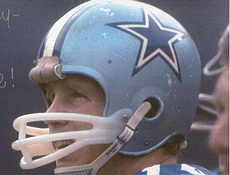 |
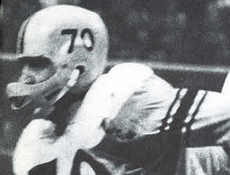 |
2. How about those three-bar masks worn by the likes of Fred Williamson
and Otis Taylor of Kansas City in the late 1960s? They look as if two
separate masks were applied to the helmet. What do you suppose made Fred and
Otis opt for this type of design?
--According to long time Chief's equipment manager Bobby Yarborough a few of
the players, including the ones you mentioned, wanted more protection for their
face than was provided by the standard Riddell plastic two bar facemask but they
did not want to use the heavier Schutt plastic coated steel bar cage facemask.
Bobby provided a solution to this problem by adding an additional Riddell
plastic one bar facemask to their existing facemask which provided increased
protection without adding significant weight (SEE PHOTO). Bobby remembers that
Fred Williamson, more than any other player, was concerned about protecting his
facial features because, as Fred often told Bobby, "someday he would become a
big movie star". Indeed Fred did go on to have a fairly significant Hollywood
career after his retirement from football. Actually the practice of using
multiple one bar facemasks goes back to the mid 1950s when they were invented.
(SEE PHOTO)
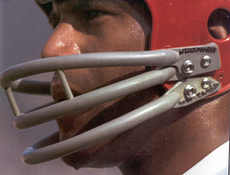 |
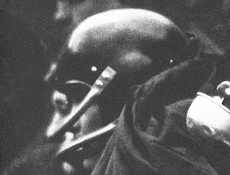 |
3. I understand the clear Lucite face masks were disbanded in the late
1950s because they were found to occasionally shatter on impact. Are
there any famous incidences of this occurring during play, either in college or
the pros?
--In 1964 Joe "The Jet" Perry of the 49ers was one of the first players to
wear the clear Lucite facemask to help protect his broken jaw. We are not aware
of any notable instances of this type of facemask shattering during play and
considering how many different players wore this type of facemask in the late
1950s, including Art Donovan, Frank Gifford, Y.A.. Titttle and Jim Brown
(Syracuse), it makes one wonder if the Lucite facemask was actually more durable
than it was reported to be.
4. Was Tommy McDonald was the last pro not to wear a face mask, or did
certain kickers continue to go mask-less after he retired? (I've seen
footage of others from the mid/late 60s without masks but can't pin it down to a
particular year.)
--The last players not to wear a facemask according to our imperfect memory
were Pat Studstill and Bobby Joe Green. Studstill wore a one bar facemask as a
receiver and wore a different helmet without a facemask while punting for the
Rams until 1971. Green served as the Bear's punter through 1974. Tommy McDonald
was the last player other than a kicker or punter to not wear a facemask What
may be more impressive is that the Boston Patriot's Jesse Richardson played
without a facemask until 1964 on the defensive line.
5. The Cleveland Browns helmet is supposed to have had a logo for a couple
of preseason games in 1965 but I have never come across any
pictorial evidence of this. Do you have any, or can you confirm or dispute this
rumor?
--In 1963, every other NFL club had a helmet logo which provided a form of
marketable identity. A decal depicting a jazzed-up "CB" was designed by Dave
Boss, then-NFL artist. It was approved and placed on the helmets at the time of
the 1964 training camp. But Boss soon heard there was a problem. The Browns felt
they didn't need razzle dazzle or a badge to establish their identity. So, just
before the first practice, they picked up their new helmets and, one by one,
peeled off the logos.
Your web-site is a continual source of fascination - thank you! Is there
any chance of putting together a book? So much of the history of
football seems represented by helmets and uniforms but there is precious little
historical information available. Any advice or recommendations you can provide
would be welcome (I live in Scotland and pretty much have to rely on the
Internet).
regards
David Wangerin
Deal HelmetHut:
I remember reading a book
about the AFL back in the early Seventies, and in it there were some
reminiscences from former New York Titans players about their cheap molded
leather helmets, which were nicknamed "flyaway" helmets because that's what they
did every time a player took a good hit. I've seen some pictures of the old
Titans and, from what I can tell, the helmets look just like regular early-60's
Riddells. When did they finally stop making leather helmets and who were the
last professional teams to wear them?
Dear Sirs:
A few of the New York Titans wore conventional Riddell suspension helmets but if
you look closer you will find that the majority of players wore the original
Macgregor plastic helmet which from a distance looked like the earlier era
Macgregor leather helmet (SEE PHOTO). The Macgregor plastic helmet was
introduced in the late 1950s and for some reason its shape was designed to look
similar to (what were they thinking) their popular vintage 1940s leather helmet
(If Macgregor had invented the automobile the body would probably be shaped like
a horse). Aside from the Titans, for whom it is rumored purchased their original
uniforms and equipment second hand in order to save money, there were only a few
other professional players who wore this unconventional shaped type Macgregor
plastic helmet including Tom Matte (Colts), Irv Cross (Eagles) and Greg Larson
(Giants). The John T. Riddell sporting goods company in Chicago, Illinois
invented and patented the first plastic helmet in 1939 and they were worn for
the first time in the 1939 Chicago College All-Star Game. The introduction of
the plastic helmet was a huge success but Riddell had to subsequently delay
production of this helmet until 1946 due to the unavailability of plastic for
non military use during World War ll. The only exception was made for the United
States Military Academy. Riddell was allowed to supply Army with the helmet and
in 1944 they became the first team to wear plastic helmets. In addition Army won
the national championship that year and also in 1945. After the war most teams
migrated from leather to the plastic helmet. The plastic helmet was outlawed by
the NFL in 1948 due to injury concerns and all professional teams wore leather
helmets for that season. The ban was lifted in 1949 and by 1950 the leather
helmet became virtually extinct at the collegiate and professional levels. Hard
to believe but while no other company even produced a leather helmet Macgregor
continued to offer both leather football helmets and plastic helmets shaped like
the old leather helmets in their catalogs as late as the mid 1960s.
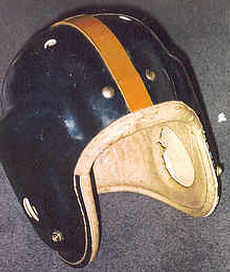 |
 |